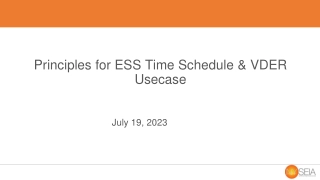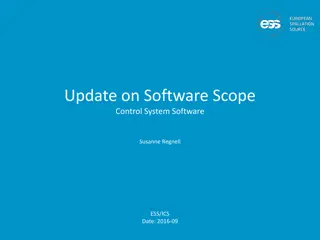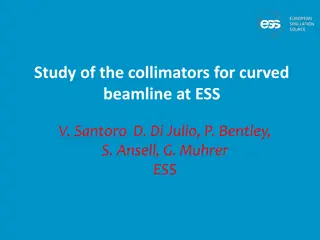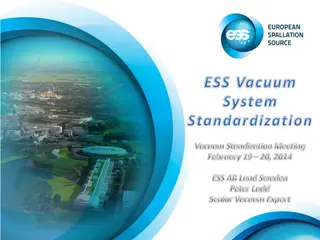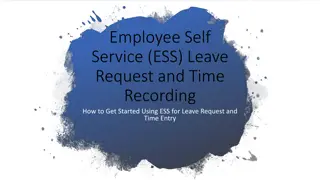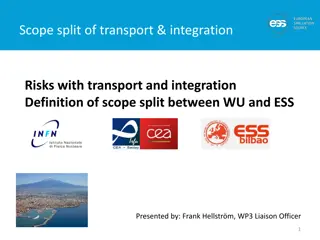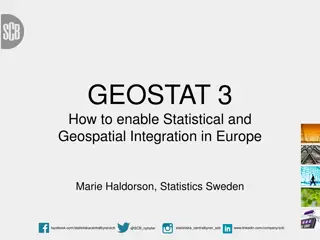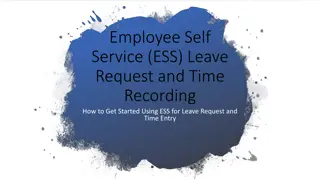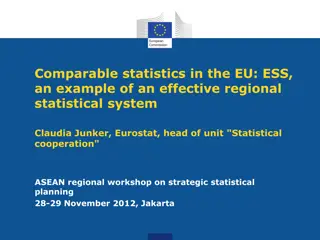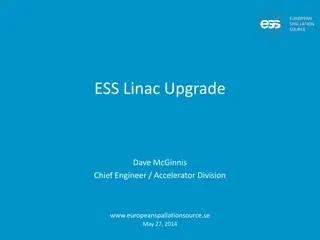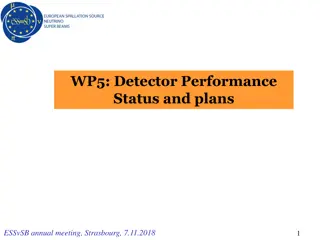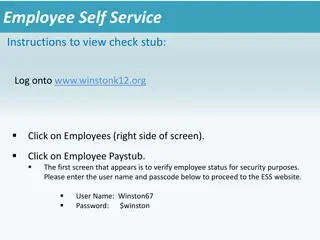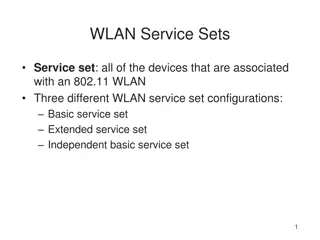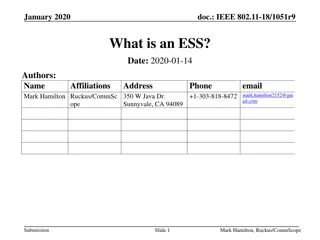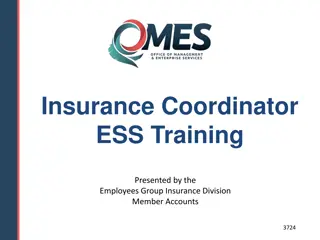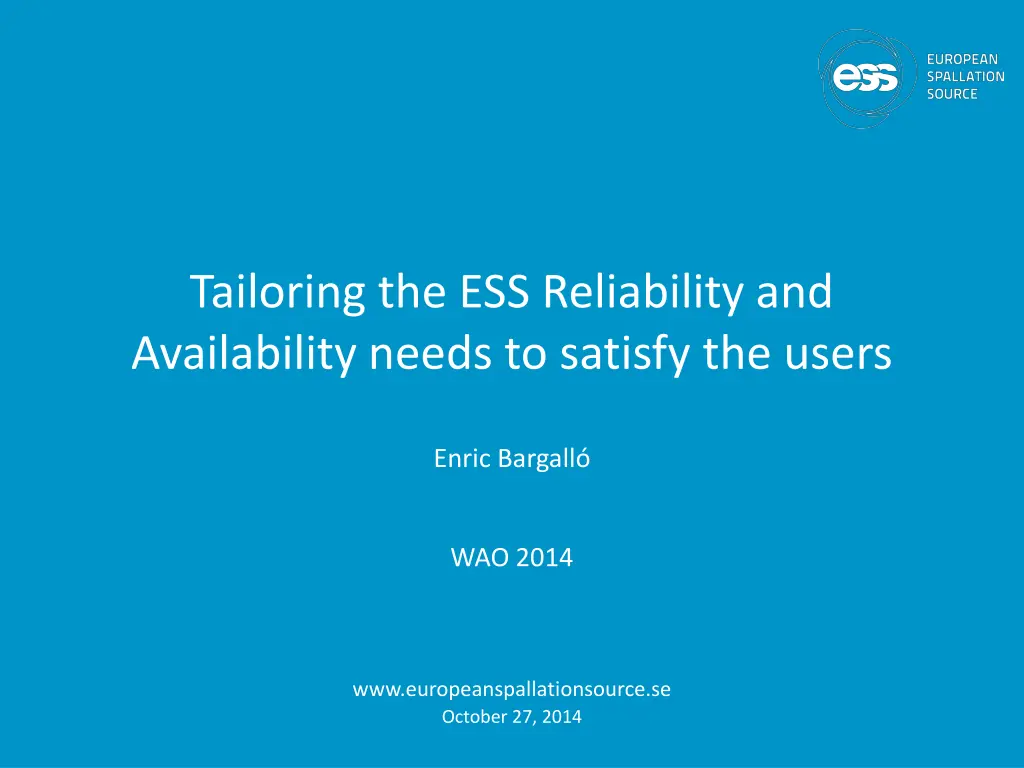
Tailoring ESS Reliability & Availability for User Satisfaction
Explore the importance of tailoring the European Spallation Source (ESS) reliability and availability to meet user needs, as discussed in Enric Bargall's presentation at WAO 2014. The focus is on defining the requirements for neutron beam availability, reliability, and quality, comparing current definitions with user expectations, and outlining future steps to enhance experimental outcomes at ESS.
Download Presentation

Please find below an Image/Link to download the presentation.
The content on the website is provided AS IS for your information and personal use only. It may not be sold, licensed, or shared on other websites without obtaining consent from the author. If you encounter any issues during the download, it is possible that the publisher has removed the file from their server.
You are allowed to download the files provided on this website for personal or commercial use, subject to the condition that they are used lawfully. All files are the property of their respective owners.
The content on the website is provided AS IS for your information and personal use only. It may not be sold, licensed, or shared on other websites without obtaining consent from the author.
E N D
Presentation Transcript
Tailoring the ESS Reliability and Availability needs to satisfy the users Enric Bargall WAO 2014 www.europeanspallationsource.se October 27, 2014
Outline Introduction Experiments at ESS and their needs Kinetic experiments Integrated-flux experiments Possible requirements Conclusions 2
ESS overview 5 MW proton accelerator providing long pulse (2.86 ms at 14 Hz) Target: Rotating wheel, He gas cooling 22 instruments Target station Neutron science systems Linear proton accelerator (600 m) 4
Objectives of this work The main goal is to clarify and document the needs of ESS users: Describe the different kinds of experiments expected at ESS Define their needs in terms of neutron beam availability, reliability and quality Compare current definitions and requirements with user needs. Examples: Failure considered only when beam trips for more than 1 minute? Is the same to have 10 trips of 10 minutes than 1 trip of 100 minutes? For how long can we operate at reduced power? Extract plausible availability and reliability requirements 5
Work done and future steps People involved Instruments scientists Reliability and availability experts With the collaboration of the ESS XFWG on Reliability Outcomes Document Experiments expected at ESS and their neutron beam needs (not yet official) Reliability and availability requirements (first proposal) Allocation between subsystems (accelerator, target, conventional ) 6
Definitions Experiment: Beamtime allocated to users. Typically one or more days. An experiment consists of a series of measurements. Measurement: The length is typically minutes or hours, but will occasionally be as short as a single ESS time frame (71ms) or as long as several days. 8
Experiments at ESS Kinetic experiments About 10% of the total number of experiments Very important, because they constitute an essential part of the science case of the ESS Short beam trips might be problematic Integrated-flux experiments About 90% of the total number of experiments Short interruptions to beam delivery has no significant impact on the experimental outcome 9
Kinetic experiments Contain one or more time-sequences of data sets measured during an irreversible process. If enough data sets fail during each time-sequence, then the measurement fails and has to be repeated. If enough measurements fail, then the user experiment fails and the beamtime needs to be rescheduled. 10
Kinetic experiments Losses with a duration of less than 1/10thof the length of the measurement will be acceptable. For example: Trips longer than 6s may not occur in the 1-minute measurements. Trips longer than 1min may not occur in the 10-minutes measurements. Typical duration of the measurements: from seconds to hours Many measurements at the 1-10 minute scale Considerable fraction of 5-10 seconds measurements Some measurements might last several hours 11
Kinetic experiments Time-scales in a kinetic measurement 12
Kinetic experiments The key metric is beam reliability: minimize the probability of having a beam trip during a measurement. A beam trip is defined as a period during which the power falls to <50% of the scheduled power. Kinetic experiments needs: a reliability of at least 90% should be provided for the duration of the measurement. The measurement will be considered failed when the beam power is reduced to less than 50% of the scheduled power for more than 1/10thof the measurement length. 13
Integrated-flux experiments Main parameter for success: integrated neutron flux over the duration of the experiment. Two metrics to quantify the beam quality: Beam availability Average beam power Short beam trips are acceptable. Some examples: 1 pulse lost: no one cares 5 seconds trip: no one cares 5 minutes trip: a few people care 2 hours of downtime: inconvenient, some measurements fail 1 day of downtime: 1-2 day experiments fail Beam trips of less than 1 minute in duration should be excluded from the availability analysis, while all others are included. 14
Integrated-flux experiments Experiments duration: No less than one day and no longer than one week (typically is 3 days). Beam availability definition: is the fraction of time over an experiment during which the beam was available at more than 50% nominal power, excluding beam trips of less than 1 minute. Integrated neutron flux experiments needs: at least 90% of the experiments should have at least 90% of beam availability and more than 80% of the scheduled beam power for the duration of the experiments. The beam will be considered unavailable when its power is less than 50% of its scheduled power for more than one minute. 15
Possible requirements for Kinetic experiments Where: - R is the reliability desired (90%) - t is the duration of the measurement (h) - is the failure rate (h-1) Measurement duration Max trip length accepted Max number of trips per day 10 seconds 1 second 1 minute 6 seconds 10 minutes 1 minute 1 hour 6 minutes 10 hours 1 hour 30 hours 3 hour 910.31 151.72 15.17 2.53 0.76 0.25 17
Possible requirements for Kinetic experiments Simplification of the requirements: Easy way to track and evaluate them Possible to compare with other facilities Beam trip bins by duration of the trip and its requirement Beam trip bins Maximum number of trips per day Approximate MTBF 1 second - 6 seconds 6 seconds - 1 minute 758.60 136.55 2 minutes 10 minutes 1 minute - 6 minutes 6 minutes - 20 minutes 12.64 1.77 2 hours 14 hours 20 minutes - 1 hour 0.51 2 days 1 hour - 3 hours 0.17 6 days 18
Comparison with values achieved at SNS 758.60 Data from SNS provided by Charles C. Peters 1000.00 136.55 100.00 12.64 Number of trips per day ESS requirements 9.19 10.00 6.70 SNS FY13-FY14 1.77 1.49 1.40 1.00 0.66 0.51 0.21 0.17 0.10 0.01 Beam trip duration 1 second - 6 seconds 6 seconds - 1 minute 1 minute - 6 minutes 6 minutes - 20 minutes 20 minutes - 1 hour 1 hour - 3 hours 19 Only some measurements Many measurements
Focus on each bin from SNS data Bin 1 - 1 second to 6 seconds Bin 2 - 6 seconds to 1 minute Bin 3 - 1 minute to 6 minutes 2.5 1.8 0.07 1.6 0.06 2 1.4 0.05 1.2 1.5 0.04 1 0.8 0.03 1 0.6 0.02 0.4 0.5 0.01 0.2 0 0 0 1 2 3 4 5 6 7 10 13 16 19 22 25 28 31 34 37 40 43 46 49 52 55 58 60 78 96 114 132 150 168 186 204 222 240 258 276 294 312 330 348 Bin 4 - 6 min to 20 min Bin 5 - 20 min to 1 hour Bin 6 - 1 hour to 3 hours 0.07 0.08 0.014 0.07 0.012 0.06 0.06 0.01 0.05 0.05 0.008 0.04 0.04 0.006 0.03 0.03 0.004 0.02 0.02 0.002 0.01 0.01 0 0 0 20 9405 3735 4140 4545 4950 5355 5760 6165 6570 6975 7380 7785 8190 8595 9000 9810 10215 10620 376 424 472 520 568 616 664 712 760 808 856 904 952 1000 1048 1096 1144 1192 1246 1430 1614 1798 1982 2166 2350 2534 2718 2902 3086 3270 3454 3638
Possible requirements for Integrated-flux experiments Duration of the experiments: From 1 day to 7 days Typically 3 days Assumptions to extract requirements Less than 90% probabilities of having an event with a duration of more than one 10thof the length of the experiment More than 90% beam availability over the duration of the experiment 21
Possible requirements for Integrated-flux experiments Data from SNS provided by George Dodson 100.00 49.75 47.30 33.72 24.02 Number of trips per year (200 days of production) 10.54 8.33 10.00 4.21 ESS requirements 2.11 SNS (2010-2013) 1.00 0.10 1h-3h 3h-8h 8h-24h More than 24h 22 Beam trip duration
Integrated-flux experiments availability Rough calculation on downtime considering No ramp-up time due to target Beam trips of more than one minute Most demanding case is for the 7 days experiments: Downtime in 7 days Short beam trips (1 minute to 1 hour) 5.02 hours Long beam trips (1 hour to 16.8 hours) 5.10 hours TOTAL 10.12 hours Beam availability for 7-days experiments is 94.3% 23
Estimation of the total downtime Rough calculation done with some assumptions Downtime per year (200 days) Short beam trips (1 minute to 1 hour) 145 hours Long beam trips (1 hour or more) 200 hours TOTAL 345 hours Beam availability for ESS would be 92.8% 24
Conclusions 25
Conclusions Good communication between the instrument scientists and the machine designers and future operators Match the expectations and needs from the users and instrument scientists to the reliability and availability values achievable by the machine More detail in the ESS reliability and availability requirements It defines specific requirements Possible to compare to other facilities Easy to track, evaluate and analyze Basic information to start ESS RAMI analyses 26
Thank you! 27
Extra slides 28
Comparison with other facilities 1000 PSI 100 Number of trips ISIS 10 1 SNS 0.1 LANSCE (H+) 0.01 1 seg - 1 min (Trips/day) 1 min - 1 h (Trips/day) Duration of the trip 1h - 3 h (Trips/day) 3h - 1 day (Trips/day) 29
RAMI definitions Reliability: probability of continuous and correct operation of a system or component during a time interval. Availability: probability of having a system or component in correct operation in a specific moment. (uptime)/(uptime + downtime) Inherent availability: scheduled operation time Operational availability: including scheduled maintenance periods Maintainability: capability of performing maintenance to a system or component. Inspectability: capability of inspect, test and monitor a system and its possible failures. 30

